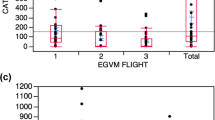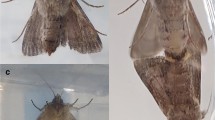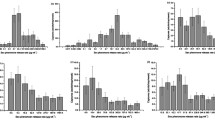Abstract
Pheromone-mediated mating disruption (MD) is currently considered an effective strategy to control the European grapevine moth (EGVM), Lobesia botrana, with a successful interference on natural female calling during the male searching flight. However, little is known on the impact of the hour of the day on EGVM male flight. While various models forecasting the day of maximum presence of males per flight have been developed, field research on the male flight activity over 24 hours is scarce. Hence, we used video camera-assisted pheromone traps to allow a continuous monitoring of EGVM flights over daylight and night hours, quantifying captures of males. Experiments were carried out in three vineyards located in northern Spain over two years (2016 and 2017). Results showed that EGVM flight mainly occurred between 21:00 and 23:00 h (GMT+1, daylight saving time). Furthermore, male catches significantly differed over the study year, annual flight period and vineyard. Most of the dispensers used worldwide for EGVM MD continuously release the main sex pheromone component [(7E,9Z)-7,9-dodecadien-1-yl acetate], except for some automatic devices releasing puffs of sex pheromones at selected time intervals. The findings presented here can be useful to optimize the MD technique, identifying selected time intervals when the release of EGVM synthetic pheromones can be concentrated, boosting MD efficacy against this important pest, minimizing the release of synthetic sex pheromone molecules in the environment and reducing application costs.



Similar content being viewed by others
References
Amo-Salas M, Ortega-Lopez V, Harman R, Alonso-Gonzalez A (2011) A new model for predicting the flight activity of Lobesia botrana (Lepidoptera: Tortricidae). Crop Prot 30:1586–1593
Anfora G, Baldessari M, De Cristofaro A, Germinara GS, Ioriatti C, Reggiori F et al (2008) Control of Lobesia botrana (Lepidoptera: Tortricidae) by biodegradable Ecodian sex pheromone dispensers. J Econ Entomol 101(2):444–450
Batiste WC (1970) A timing sex-pheromone trap with special reference to codling moth collections. J Econ Entomol 63(3):915–918
Batiste WC, Olson WH, Berlowitz A (1973a) Codling moth: influence of temperature and daylight intensity on periodicity of daily flight in the field. J Econ Entomol 66(4):883–892
Batiste WC, Olson WH, Berlowitz A (1973b) Codling moth: diel periodicity of catch in synthetic sex attractant versus female-baited traps. Environ Entomol 2(4):673–676
Bovey P (1966) Super-famille des Tortricoidea. In: Balachowsky AS (ed) Entomologie appliqué à l’agriculture. Tome II. Lépidopterés, premier volume. Masson et Cie, Paris, pp 461–486, pp 859–887
Brockerhoff EG, Suckling DM, Kimberley M, Richardson B, Coker G, Gous S, Kerr JL, Cowan DM, Lance DR, Strand T, Zhang A (2012) Aerial application of pheromones for mating disruption of an invasive moth as a potential eradication tool. PLoS ONE 7(8):e43767. https://doi.org/10.1371/journal.pone.0043767
Byers JA (2006) Pheromone component patterns of moth evolution revealed by computer analysis of the Pherolist. J Anim Ecol 75(2):399–407
Cooper M, Varela LG, Smith RJ, Whitmer DR, Simmons GA, Lucchi A, Broadway R, Steinhauer R (2014) Growers, scientists and regulators collaborate on European grapevine moth program. Calif Agric 4:125–133
El-Sayed A, Gödde J, Witzgall P, Arn H (1999) Characterization of pheromone blend for grapevine moth, Lobesia botrana by using flight track recording. J Chem Ecol 25:389–400
El-Sayed AM, Gödde J, Arn H (2000) A computer-controlled video system for real-time recording of insect flight in three dimensions. J Insect Behav 13:881–900
Gabel B, Stockel J (1988) Studies of the flight behaviour of the European vine moth, Lobesia botrana Den. et Schiff. (Lep., Tortricidae). J Appl Entomol 105:205–211
Gallardo A, Ocete R, Lopez MA, Maistrello L, Ortega F, Samedo A, Soria FJ (2009) Forecasting the flight activity of Lobesia botrana (Denis & Schiffermuller) (Lepidoptera, Tortricidae) in Southwestern Spain. J Appl Entomol 133:626–632
Götz B (1939) Untersuchungen über die Wirkung des Sexualduftstoffes bei den Traubenwicklern Clysia ambiguella und Polychrosis botrana. Z. Angew Entomol 26:143–164
Götz B (1943) Freiland- und Laboratoriums-Untersuchungen über Ausschlüpfen, Eiablage und Nahrungsaufnahme bei den Traubenwicklern Clysia ambiguella und Polychrosis botrana. Wein und Rebe 25:135–153
Groot AT (2014) Circadian rhythms of sexual activities in moths: a review. Front Ecol Evol 2:43
Harari AR, Zahavi T, Thiéry D (2011) Fitness cost of pheromone production in signaling female moths. Evolution 65(6):1572–1582
Harari AR, Zahavi T, Steinitz H (2015) Female detection of the synthetic sex pheromone contributes to the efficacy of mating disruption of the European grapevine moth, Lobesia botrana. Pest Manag Sci 71:316–322
Haynes KF, Birch MC (1986) Temporal reproductive isolation between 2 species of plume moths (Lepidoptera, Pterophoridae). Ann Entomol Soc Am 79:210–215
Hummel HE (2017) A brief review on Lobesia botrana mating disruption by mechanically distributing and releasing sex pheromones from biodegradable mesofiber dispensers. Biochem Mol Biol J 3:1–4
Hurtrel B, Thiéry D (1999) Modulation of flight activity in Lobesia botrana Den & Schiff. (Lepidoptera: Tortricidae) females studied in wind tunnel. J Insect Behav 12:199–211
Ioriatti C, Lucchi A (2016) Semiochemical strategies for tortricid moth control in apple orchards and vineyards in Italy. J Chem Ecol 42(7):571–583
Ioriatti C, Lucchi A, Bagnoli B (2008) Grape areawide pest management in Italy. In: Koul et al (ed) Areawide pest management: theory and implementation. CAB International, Wallingford, pp 208–225
Ioriatti C, Anfora G, Tasin M, De Cristofaro A, Witzgall P, Lucchi A (2011) Chemical ecology and management of Lobesia botrana (Lepidoptera: Tortricidae). J Econ Entomol 104(4):1125–1137
Ioriatti C, Lucchi A, Varela LG (2012) Grape berry moths in Western European vineyards and their recent movement into the New World. In: Bostanian NJ et al (eds) Arthropod management in vineyards: pests, approaches, and future directions. Springer, Berlin. https://doi.org/10.1007/978-94-007-4032-7_14
Lance DR, Leonard DS, Mastro VC, Walters ML (2016a) Mating disruption as a suppression tactic in programs targeting regulated lepidopteran pests in US. J Chem Ecol 42(7):590–605
Lance DR, Leonard DS, Mastro VC, Walters ML (2016b) Towards pesticide-free farming? Sharing needs and knowledge promotes integrated pest management. Environ Sci Poll Res. https://doi.org/10.1007/s11356-018-1919-0
Lucchi A, Benelli G (2018) Towards pesticide-free farming? Sharing needs and knowledge promotes Integrated Pest Management. Environ Sci Poll Res https://doi.org/10.1007/s11356-018-1919-0
Lucchi A, Ladurner E, Iodice A, Savino F, Ricciardi R, Cosci F, Conte G, Benelli G (2018a) Eco-friendly pheromone dispensers—a green route to manage the European grapevine moth? Environ Sci Poll Res. 25(10), 9426–9442, https://doi.org/10.1007/s11356-018-1248-3
Lucchi A, Sambado P, Juan Royo AB, Bagnoli B, Conte G, Benelli G (2018b) Disrupting mating of Lobesia botrana using sex pheromone aerosol devices. Environ Sci Poll Res. https://doi.org/10.1007/s11356-018-2341-3
Metcalf RL (1962) Destructive and useful insects, their habits and control, 4th edn. McGraw-Hill Book Co., New York, pp 403–404
Millar JG (2007) Insect pheromones for integrated pest management: promise versus reality. Redia 90:51–55
Miller JR, Gut LJ (2015) Mating disruption for the 21st Century: matching technology with mechanism. Environ Entomol 44(3):427–453
Miller JR, Gut LJ, De Lame FM, Stelinski LL (2006) Differentiation of competitive versus non-competitive mechanisms mediating disruption of moth sexual communication by point sources of sex pheromone (Part 2): case studies. J Chem Ecol 32(10):2115–2143
Muller K, Arenas L, Thiéry D, Moreau J (2016) Direct benefits from choosing a virgin male in the European grapevine moth, Lobesia botrana. Animal Behav 114:165–172
Navarro-Roldán MA, Gemeno C (2017) Sublethal effects of neonicotinoid insecticide on calling behavior and pheromone production of tortricid moths. J Chem Ecol 43(9):881–890
Reineke A, Thiéry D (2016) Grapevine insect pests and their natural enemies in the age of global warming. J Pest Sci 89:313–328
Roelofs WL, Cardé RT (1974) Sex pheromones in the reproductive isolation of lepidopterous species. In: Birch MC (ed) pheromones. North Holland Publishing, Amsterdam, pp 96–114
Ting D, Eya DB (2010) Human Health Risk Assessment of Isomate®-EGVM. Report reviewed by the Department of Pesticide Regulation, California Environmental Protection Agency and the California Department of Public Health, 39 pp
Welter S, Pickel C, Millar J, Cave F, Van Steenwyk R, Dunley J (2005) Pheromone mating disruption offers selective management options for key pests. Calif Agric 59(1):16–22
Witzgall P, Arn H (1990) Direct measurement of the flight behavior of male moths to calling females and synthetic sex pheromones. Zeitsch Naturforsch 45:1067–1069
Witzgall P, Kirsch P, Cork A (2010) Sex pheromones and their impact on Pest Management. J Chem Ecol 36(1):80–100
Acknowledgements
The authors are grateful to Trapview (Hruševje, Slovenia) e CBC Iberia (Barcelona, Spain) for their technical assistance, as well as for the tools and facilities kindly provided.
Author information
Authors and Affiliations
Corresponding author
Ethics declarations
Conflict of interest
The authors declare no competing interests. The mention of trade names or commercial products in this publication is solely to provide specific information and does not imply recommendation or endorsement by the author institutions.
Additional information
Communicated by P. G. Becher.
Rights and permissions
About this article
Cite this article
Lucchi, A., Sambado, P., Juan Royo, A.B. et al. Lobesia botrana males mainly fly at dusk: video camera-assisted pheromone traps and implications for mating disruption. J Pest Sci 91, 1327–1334 (2018). https://doi.org/10.1007/s10340-018-1002-0
Received:
Revised:
Accepted:
Published:
Issue Date:
DOI: https://doi.org/10.1007/s10340-018-1002-0




